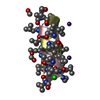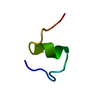+ Open data
Open data
- Basic information
Basic information
| Entry | Database: PDB / ID: 1hz3 | ||||||
|---|---|---|---|---|---|---|---|
| Title | ALZHEIMER'S DISEASE AMYLOID-BETA PEPTIDE (RESIDUES 10-35) | ||||||
 Components Components | A-BETA AMYLOID | ||||||
 Keywords Keywords | SUGAR BINDING PROTEIN / collapsed coil / hydrophobic cluster / hydrophobic patch | ||||||
| Function / homology |  Function and homology information Function and homology informationregulation of epidermal growth factor-activated receptor activity / signaling receptor activator activity / collateral sprouting in absence of injury / cytosolic mRNA polyadenylation / microglia development / regulation of synapse structure or activity / Formyl peptide receptors bind formyl peptides and many other ligands / axo-dendritic transport / synaptic assembly at neuromuscular junction / smooth endoplasmic reticulum calcium ion homeostasis ...regulation of epidermal growth factor-activated receptor activity / signaling receptor activator activity / collateral sprouting in absence of injury / cytosolic mRNA polyadenylation / microglia development / regulation of synapse structure or activity / Formyl peptide receptors bind formyl peptides and many other ligands / axo-dendritic transport / synaptic assembly at neuromuscular junction / smooth endoplasmic reticulum calcium ion homeostasis / axon midline choice point recognition / astrocyte activation involved in immune response / regulation of spontaneous synaptic transmission /  regulation of Wnt signaling pathway / mating behavior / regulation of Wnt signaling pathway / mating behavior /  ciliary rootlet / Lysosome Vesicle Biogenesis / ciliary rootlet / Lysosome Vesicle Biogenesis /  PTB domain binding / Golgi-associated vesicle / positive regulation of amyloid fibril formation / neuron remodeling / Insertion of tail-anchored proteins into the endoplasmic reticulum membrane / : / Deregulated CDK5 triggers multiple neurodegenerative pathways in Alzheimer's disease models / presynaptic active zone / nuclear envelope lumen / modulation of excitatory postsynaptic potential / suckling behavior / COPII-coated ER to Golgi transport vesicle / dendrite development / PTB domain binding / Golgi-associated vesicle / positive regulation of amyloid fibril formation / neuron remodeling / Insertion of tail-anchored proteins into the endoplasmic reticulum membrane / : / Deregulated CDK5 triggers multiple neurodegenerative pathways in Alzheimer's disease models / presynaptic active zone / nuclear envelope lumen / modulation of excitatory postsynaptic potential / suckling behavior / COPII-coated ER to Golgi transport vesicle / dendrite development /  smooth endoplasmic reticulum / smooth endoplasmic reticulum /  regulation of NMDA receptor activity / TRAF6 mediated NF-kB activation / Advanced glycosylation endproduct receptor signaling / neuromuscular process controlling balance / regulation of presynapse assembly / The NLRP3 inflammasome / intracellular copper ion homeostasis / transition metal ion binding / regulation of multicellular organism growth / negative regulation of long-term synaptic potentiation / negative regulation of neuron differentiation / ECM proteoglycans / spindle midzone / positive regulation of T cell migration / regulation of NMDA receptor activity / TRAF6 mediated NF-kB activation / Advanced glycosylation endproduct receptor signaling / neuromuscular process controlling balance / regulation of presynapse assembly / The NLRP3 inflammasome / intracellular copper ion homeostasis / transition metal ion binding / regulation of multicellular organism growth / negative regulation of long-term synaptic potentiation / negative regulation of neuron differentiation / ECM proteoglycans / spindle midzone / positive regulation of T cell migration /  Purinergic signaling in leishmaniasis infection / positive regulation of calcium-mediated signaling / forebrain development / regulation of peptidyl-tyrosine phosphorylation / positive regulation of chemokine production / Purinergic signaling in leishmaniasis infection / positive regulation of calcium-mediated signaling / forebrain development / regulation of peptidyl-tyrosine phosphorylation / positive regulation of chemokine production /  clathrin-coated pit / clathrin-coated pit /  Notch signaling pathway / positive regulation of G2/M transition of mitotic cell cycle / ionotropic glutamate receptor signaling pathway / positive regulation of protein metabolic process / neuron projection maintenance / cholesterol metabolic process / extracellular matrix organization / positive regulation of glycolytic process / positive regulation of mitotic cell cycle / response to interleukin-1 / Notch signaling pathway / positive regulation of G2/M transition of mitotic cell cycle / ionotropic glutamate receptor signaling pathway / positive regulation of protein metabolic process / neuron projection maintenance / cholesterol metabolic process / extracellular matrix organization / positive regulation of glycolytic process / positive regulation of mitotic cell cycle / response to interleukin-1 /  axonogenesis / adult locomotory behavior / trans-Golgi network membrane / dendritic shaft / locomotory behavior / platelet alpha granule lumen / positive regulation of peptidyl-threonine phosphorylation / axonogenesis / adult locomotory behavior / trans-Golgi network membrane / dendritic shaft / locomotory behavior / platelet alpha granule lumen / positive regulation of peptidyl-threonine phosphorylation /  learning / learning /  central nervous system development / positive regulation of interleukin-1 beta production / positive regulation of long-term synaptic potentiation / astrocyte activation / endosome lumen / synapse organization / central nervous system development / positive regulation of interleukin-1 beta production / positive regulation of long-term synaptic potentiation / astrocyte activation / endosome lumen / synapse organization /  Post-translational protein phosphorylation / regulation of long-term neuronal synaptic plasticity / positive regulation of JNK cascade / microglial cell activation / TAK1-dependent IKK and NF-kappa-B activation / Post-translational protein phosphorylation / regulation of long-term neuronal synaptic plasticity / positive regulation of JNK cascade / microglial cell activation / TAK1-dependent IKK and NF-kappa-B activation /  visual learning / visual learning /  neuromuscular junction / serine-type endopeptidase inhibitor activity / recycling endosome / neuromuscular junction / serine-type endopeptidase inhibitor activity / recycling endosome /  cognition / positive regulation of inflammatory response / Golgi lumen / neuron cellular homeostasis / cognition / positive regulation of inflammatory response / Golgi lumen / neuron cellular homeostasis /  endocytosis / positive regulation of interleukin-6 production / positive regulation of non-canonical NF-kappaB signal transduction / cellular response to amyloid-beta / Regulation of Insulin-like Growth Factor (IGF) transport and uptake by Insulin-like Growth Factor Binding Proteins (IGFBPs) / neuron projection development / positive regulation of DNA-binding transcription factor activity / G2/M transition of mitotic cell cycle / cell-cell junction / endocytosis / positive regulation of interleukin-6 production / positive regulation of non-canonical NF-kappaB signal transduction / cellular response to amyloid-beta / Regulation of Insulin-like Growth Factor (IGF) transport and uptake by Insulin-like Growth Factor Binding Proteins (IGFBPs) / neuron projection development / positive regulation of DNA-binding transcription factor activity / G2/M transition of mitotic cell cycle / cell-cell junction /  synaptic vesicle / positive regulation of tumor necrosis factor production / synaptic vesicle / positive regulation of tumor necrosis factor production /  regulation of translation regulation of translationSimilarity search - Function | ||||||
| Method |  SOLUTION NMR / distance geometry, SOLUTION NMR / distance geometry,  simulated annealing, and restrained molecular dynamics simulated annealing, and restrained molecular dynamics | ||||||
 Authors Authors | Zhang, S. / Iwata, K. / Lachenmann, M.J. / Peng, J.W. / Li, S. / Stimson, E.R. / Lu, Y. / Felix, A.M. / Maggio, J.E. / Lee, J.P. | ||||||
 Citation Citation |  Journal: J.Struct.Biol. / Year: 2000 Journal: J.Struct.Biol. / Year: 2000Title: The Alzheimer's peptide a beta adopts a collapsed coil structure in water. Authors: Zhang, S. / Iwata, K. / Lachenmann, M.J. / Peng, J.W. / Li, S. / Stimson, E.R. / Lu, Y. / Felix, A.M. / Maggio, J.E. / Lee, J.P. #1:  Journal: Biochemistry / Year: 1995 Journal: Biochemistry / Year: 1995Title: 1H NMR of A-Beta Amyloid Peptide Congeners in Water Solution. Conformational Changes Correlate with Plaque Competence. Authors: Lee, J.P. / Stimson, E.R. / Ghilardi, J.R. / Mantyh, P.W. / Lu, Y.A. / Felix, A.M. / Llanos, W. / Behbin, A. / Cummings, M. / Van Criekinge, M. / Timms, W. / Maggio, J.E. #2:  Journal: Biophys.J. / Year: 2001 Journal: Biophys.J. / Year: 2001Title: Simulation Study of the Structure and Dynamics of the Alzheimer's Amyloid Peptide Congener in Solution. Authors: Massi, F. / Peng, J.W. / Lee, J.P. / Straub, J.E. #3:  Journal: Proteins / Year: 2001 Journal: Proteins / Year: 2001Title: Energy Landscape Theory for Alzheimer's Amyloid Beta-Peptide Fibril Elongation Authors: Massi, F. / Straub, J.E. | ||||||
| History |
| ||||||
| Remark 999 | SEQUENCE The peptide residues are numbered 1-26 as they were designated in the distance-geometry ...SEQUENCE The peptide residues are numbered 1-26 as they were designated in the distance-geometry calculation. This corresponds to residues 10-35 of the "Human amyloid peptide Abeta." Abeta is a 40-43 residue peptide derived from the Human amyloid precursor protein (APP) (accession QRHUA4). Residue #10 in Abeta corresponds to residue #681 in APP, and residue #35 in Abeta corresponds to residue #706 in APP. |
- Structure visualization
Structure visualization
| Structure viewer | Molecule:  Molmil Molmil Jmol/JSmol Jmol/JSmol |
|---|
- Downloads & links
Downloads & links
- Download
Download
| PDBx/mmCIF format |  1hz3.cif.gz 1hz3.cif.gz | 124.9 KB | Display |  PDBx/mmCIF format PDBx/mmCIF format |
|---|---|---|---|---|
| PDB format |  pdb1hz3.ent.gz pdb1hz3.ent.gz | 106.4 KB | Display |  PDB format PDB format |
| PDBx/mmJSON format |  1hz3.json.gz 1hz3.json.gz | Tree view |  PDBx/mmJSON format PDBx/mmJSON format | |
| Others |  Other downloads Other downloads |
-Validation report
| Arichive directory |  https://data.pdbj.org/pub/pdb/validation_reports/hz/1hz3 https://data.pdbj.org/pub/pdb/validation_reports/hz/1hz3 ftp://data.pdbj.org/pub/pdb/validation_reports/hz/1hz3 ftp://data.pdbj.org/pub/pdb/validation_reports/hz/1hz3 | HTTPS FTP |
|---|
-Related structure data
| Similar structure data |
|---|
- Links
Links
- Assembly
Assembly
| Deposited unit | 
| |||||||||
|---|---|---|---|---|---|---|---|---|---|---|
| 1 |
| |||||||||
| NMR ensembles |
|
- Components
Components
| #1: Protein/peptide | Mass: 2907.345 Da / Num. of mol.: 1 / Fragment: RESIDUES 10-35 / Source method: obtained synthetically Details: This sequence is taken from the A-Beta peptide, which occurs naturally in Homo sapiens (human). The peptide was synthesized by Merrifield solid-phase methodology. References: UniProt: P05067 |
|---|
-Experimental details
-Experiment
| Experiment | Method:  SOLUTION NMR SOLUTION NMR | ||||||||||||||||||||||||||||
|---|---|---|---|---|---|---|---|---|---|---|---|---|---|---|---|---|---|---|---|---|---|---|---|---|---|---|---|---|---|
| NMR experiment |
| ||||||||||||||||||||||||||||
| NMR details | Text: Many observed intra-residue NOE-based distance constraints were not included in the structure calculations. |
- Sample preparation
Sample preparation
| Details |
| |||||||||||||||
|---|---|---|---|---|---|---|---|---|---|---|---|---|---|---|---|---|
| Sample conditions | Ionic strength: <1mM / pH: 5.6 / Pressure: ambient / Temperature: 283 K | |||||||||||||||
Crystal grow | *PLUS Method: other / Details: NMR |
-NMR measurement
| NMR spectrometer |
|
|---|
- Processing
Processing
| NMR software |
| ||||||||||||||||
|---|---|---|---|---|---|---|---|---|---|---|---|---|---|---|---|---|---|
| Refinement | Method: distance geometry,  simulated annealing, and restrained molecular dynamics simulated annealing, and restrained molecular dynamicsSoftware ordinal: 1 Details: The structures are based on a total of 84 sequential, 66 medium- (i to i+2 or i+3) and 32 long-range NOE-derived distance constraints. | ||||||||||||||||
| NMR representative | Selection criteria: fewest violations | ||||||||||||||||
| NMR ensemble | Conformer selection criteria: structures with the lowest energy Conformers calculated total number: 40 / Conformers submitted total number: 15 |
 Movie
Movie Controller
Controller









 PDBj
PDBj














